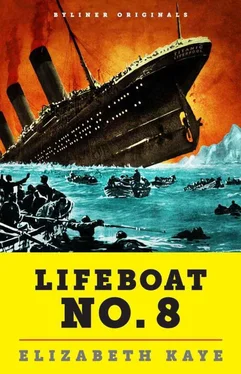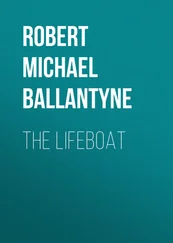Every ship is supposed to have a lifeboat drill, but there had been none aboard the Titanic . Most passengers did not even know where their life belts were kept. The Countess and her cousin Gladys had to ask a steward to find theirs. “I’m sure it’s unnecessary,” he said, “to put them on.”
“No,” the Countess replied firmly, “we’ve been ordered to do so.”
The steward fetched the life belts from atop the suite’s exquisite wardrobe. Then the Countess and Gladys dressed in woolen suits. Gladys topped hers with a seal wrap; the Countess put on a full-length ermine coat, placed her small brandy flask in one pocket, and fastened around her swanlike neck a strand of three-hundred-year-old pearls, a precious heirloom that she had worn at dinner just a few hours earlier. Her other jewelry, fine pieces configured from pearls and diamonds, remained in their satinwood box.
As the two women left the suite, Gladys picked up a miniature photograph of her mother. How silly, she thought. We shall soon be back here. She placed the miniature on the dressing table and walked out the cabin door.
On the way to the deck, they passed the assistant purser, Ernest Brown. He tipped his hat as they went swiftly by. “It is quite all right,” he told them, “don’t hurry!”
What a lovely night, the Countess thought as she walked out onto the Boat Deck. She stood near Colonel John Jacob Astor and his wife, Madeleine, a sweet-faced eighteen-year-old who was one year younger than her husband’s son. Lavished with riches by her doting forty-seven-year-old husband, Mrs. Astor was attired in a diamond necklace and a black broadtail coat with a sable lining, as if dressed for afternoon tea at the Ritz.
John Jacob Astor was the wealthiest traveler on board and one of America’s richest men. At a time when the upper class took a dim view of divorce, he had committed the dual sin of shedding his first wife and wedding a teenager. Their recent marriage had met with such disparaging gossip among New York society that they had decided to winter abroad. But now Mrs. Astor was pregnant; they wanted their child to be born in America, so they were heading home, accompanied by his valet, her maid, a nurse, and their Airedale, Kitty.
The Countess was impressed by Mrs. Astor’s calm, but then every first-class passenger was calm, for they all believed they would soon be told to go back to bed, and that the order to wear life belts and stand on deck was nothing more than a precaution issued by a seasoned captain known to err on the side of safety.
And so they chatted among themselves, contented, self-assured travelers returning from sojourns to Egypt or Paris, or from wintering in Baden-Baden or Cap Martin, unaware that these were the last hours of their lives or, if they proved to be among the lucky ones, the last in which they would ever be absolutely certain of anything.
“Ladies, come forward,” an officer shouted, his voice amplified by a megaphone. “Ready yourselves to get into the boats.”
He repeated the order several times, but not one passenger stepped forward. No one thought for a moment that the ship was going to sink, not even the officers poised to fill the lifeboats. Why, Caroline Bonnell wondered, would we trust ourselves to tiny open rowboats when we are aboard the biggest liner in the world?
The Titanic was not merely the biggest liner: At nearly a sixth of a mile long and ten stories high, she was the largest man-made moving object ever built, so immense that on her test launch it had taken twenty-two tons of tallow and soap to ease her down the slipway. The immoderate boast of the White Star Line was that she was “practically unsinkable,” but in 1912, when technological pride had morphed into technological arrogance, that essential qualifier had been summarily deleted.
Finally, with repeated urgings from the ship’s officers, the women moved toward the railing and the men drew back, a bit of graceful choreography that ultimately would have the effect of dividing the dead from the living.
Sarah Daniels stepped out on the Boat Deck and beheld an astonishing sight: a gathering of first-class passengers that would have looked like a party were it not for the seamen placing blankets in the lifeboats and scurrying about while a dozen assistant bakers, each carrying four loaves of bread, distributed their goods among the boats.
She ran back to the Allisons’ suite to implore them to dress and come up to the Boat Deck. But her pleas succeeded only in further enraging Mr. Allison.
Mr. and Mrs. Emil Taussig came onto the deck just as Captain Smith and several officers were preparing Lifeboat No. 8. Even then, the white-bearded, patriarchal captain cut a reassuring figure, no small feat for a beaten man whose heart was breaking.
Mr. Taussig gently guided his eighteen-year-old daughter, Ruth, to the Captain, who held out his hand and helped her into the empty boat. Ruth perched on one of the four wooden seats. She looked very small and very frightened. Then Captain Edwards extended his hand to Mrs. Taussig.
“I will not go,” she told him, “if my husband cannot accompany me.”
“I cannot allow it,” the Captain said.
“But my husband is an expert oarsman,” she insisted.
“I would be happy to volunteer my services,” said Mr. Taussig.
“No,” said the captain. “It’s women and children only.”
Tillie Taussig held tight to her husband’s arm. He insisted she get into the boat, but she refused. She held on to him even as he backed away and joined the other men who had helped their wives and children into lifeboats, kissed them, held them, and walked away. For men traveling in first class, such gallantry was instinctive, a function of habit and breeding so ingrained as to render unnecessary the command “All men stand back from the boats.” Still, the irony of his particular situation would not have been lost on Mr. Taussig, who was a major shareholder in the company that built some of the Titanic ’s lifeboats and had long campaigned to increase the number of lifeboats a ship must carry.
Two stewards broke through the crowd and rushed up to Lifeboat No. 8. “Do you know how to row?” the Captain asked them.
“Yes, sir,” they said.
“Then get in,” said the Captain.
“My husband can row!” Tillie Taussig called out. But Captain Smith ignored her.
Sarah Daniels returned to the Boat Deck, where several lifeboats were half filled with women and children whose eyes were fixed on husbands and fathers who stood nearby, silent, solemn, nodding encouragingly. A seaman grabbed her arm and steered her toward the lifeboats. She resisted, but he managed to drag her a few feet before she broke away, shouting, “I have to look after the Allisons!”
Gently, he told her, “I’ll make sure that the Allisons are safe.”
Sarah looked into his eyes. He seemed to mean it. She held out her hand. He helped her into Lifeboat No. 8.
Mr. and Mrs. Isidor Straus came up to the Boat Deck warmly dressed: she in a fur coat, he in a fur-lined overcoat in which he carried a silver flask and a silver bottle containing smelling salts. They had been married for thirty-one years, during which time Mr. Straus and his brother had bought Macy’s department store and turned it into a retail phenomenon. Isidor Straus was the third-richest man on board, his wealth surpassed only by that of John Jacob Astor and Benjamin Guggenheim.
Mr. Straus was sixty-seven; Ida, his wife, was sixty-one—considerable ages at a time when life expectancy was 48.4 years for men and 51.8 for women. Throughout their married life, they had been inseparable. Ida Straus was fiercely dedicated to her husband and their six children, so much so that in his will Mr. Straus had urged her to use her inheritance to “be a little selfish.”
Читать дальше












